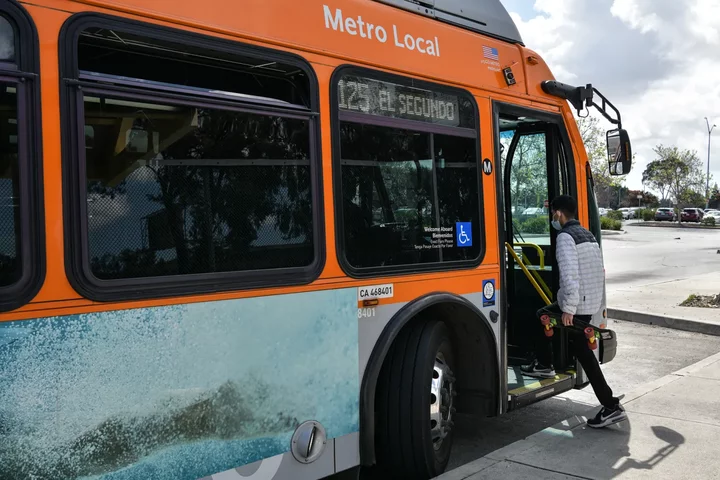Commuters quickly jump on the Metro bus at the Norwalk Green Line Station in Norwalk on April 3, 2023. Photo by Pablo Unzueta, CalMatters
###
California is grappling with a $31.5 billion budget deficit. Gov. Gavin Newsom denied public transit agencies a lifeline in his latest spending plan, and time is running out.
But transit officials and their supporters in the Legislature aren’t giving up hope yet that the state will offer at least some aid. And Friday, the California Transit Association delivered a plan for how individual agencies should ask for money — and how they would be held accountable for how they spend it.
Transit agencies are seeking $5.15 billion in operating funds over the next five years — warning that without substantial cash, they’ll fall deep into a financial pit caused by a continued decline in ridership since the pandemic and the drying up of federal funds.
Without some kind of financial infusion, Muni — San Francisco’s bus system — may have to start cutting bus lines this summer. Other transit systems are issuing similar dire forecasts.
If services are cut, commuters will be impacted, as will working people who can’t afford their own cars — and certainly not electric vehicles. Increased use of public transit is key to reducing carbon emissions and reaching the state’s climate goals championed by Newsom and Democratic leaders.
But in his updated budget plan unveiled this month, the governor committed only to working with the Legislature to find a solution.
“You can’t do everything,” he said at his May 12 budget briefing. “It’s about balancing other priorities.”
The state Senate wants to make public transit a priority. In its spending proposal, it included the $5.15 billion as “bridge funding.” Supporters say the money can come from a mix of sources that already support transit and would reduce general fund revenue by only $213 million.
TransForm, an advocacy group focused on transit and housing inequities, said it was disappointed in Newsom’s decision.
“The $2.5 billion needed to save Bay Area transit is less costly, in terms of dollars, people, and the planet than the $5 billion in additional transportation costs that will be paid by the people who can least afford it,” said Zack Deutsch-Gross, TransForm policy director.
The budget negotiations are well underway, with a June 15 deadline for the Legislature to pass a budget to keep collecting pay.
Call for help too late?
At a town hall on May 12, Assemblymember Phil Ting, a Democrat from San Francisco and chairperson of the Assembly budget committee, said transit agencies should have been better prepared, and should have “sounded the alarm earlier.”
“Having said that, we are where we are. We can’t change the past,” Ting said.
He said that legislators in the Bay Area Caucus that he leads are focused on the issue and are committed to making sure agencies don’t go over the “fiscal cliff.”
“We know that once these agencies have to stop service, it’s very difficult to turn it back on,” he said.
Ting said that given the budget shortfall, the goal is to help get agencies to solid enough ground to pursue a local ballot measure for long-term financial sustainability.
But he also said that for the state to help, transit representatives needed to present a spending plan and demonstrate accountability.
On Friday, the California Transit Association, which represents agencies throughout the state, responded with its proposal, which includes an 18-month deadline to report how funds are spent. Sent to Newsom and legislative leaders, the blueprint is based on recovery plans previously created by the Bay Area’s regional transportation commission and the Los Angeles Metropolitan Transportation Authority, as well as a bill this session from Burbank-area Democratic Assemblymember Laura Friedman on transit oversight.
The association also noted that its proposal won’t solve all of the underlying issues.
“As we advance this accountability and reform framework, we continue to elevate that significant external challenges will continue to impact agencies’ budgets, operating environments, and ridership levels, including, the hollowing out of downtown cores, the housing crisis, and rise in violent crime,” it said in a statement.
The proposal, however, doesn’t satisfy concerns from some lawmakers, including state Sen. Steve Glazer, who has been vocal in his criticism of BART oversight. BART officials previously responded to some of those concerns, saying the “fiscal cliff” has more to do with the agency’s financial model rather than specific expenses and missteps.
“I thought it was an April Fool’s joke delivered in May,” Glazer told CalMatters of the association’s proposal. “Self-policing is not accountability.” Meanwhile, agencies have already begun to make some changes to boost ridership, including BART ramping up service on its most popular line between Antioch and San Francisco, and L.A. Metro ramping up both homelessness services and microtransit.
But those changes aren’t cheap.
Bevan Dufty, a member of the BART board of directors, said in April: “We really can’t cut our way out of this.”
###
CalMatters.org is a nonprofit, nonpartisan media venture explaining California policies and politics.

CLICK TO MANAGE